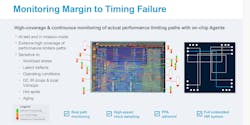Assembling Chips with Built-in Telemetry for AI Analysis
What you'll learn:
- Why build telemetry into chips?
- How does artificial-intelligence analysis work with chip telemetry?
How do you know when a chip is running correctly? Any idea when or why it might fail?
Lots of variables are involved in determining how well a chip is operating because it doesn’t simply come down to the results of some computation or how well a chip might be controlling a motor right now. Artificial intelligence and machine learning (AI/ML) is being used to check the health of the motor, but what about the health of the chip? That requires a different set of sensors. This is where proteanTecs comes into play with on-chip support to deliver status information for AI analysis (Fig. 1).
I talked with Noam Brousard, Vice President Solutions Engineering at proteanTecs, about the company’s on-chip telemetry solution.
The Challenge of Adding Chip Telemetry
Developers often utilize JTAG for debugging and event tracking features like Arm’s Embedded Trace Macrocell (ETM) can provide information about the computations being performed. However, they typically lack details like chip temperature or other aspects that would be useful in providing overall chip health information. Arm’s Performance Monitoring Unit (PMU) is also focused on the computational units, which are only a part of the system.
proteanTecs’ support works in a similar fashion, being included as additional IP called Agents within the chip design, but it targets different details that can provide insight into the health of the chip (Fig. 2). This information is pulled in a fashion similar to JTAG, ETM, or PMU data, so it can be uploaded to the cloud for analysis. AI models are able to be trained on this data to detect potential problems, defects, or future problems.
Over a dozen standard Agents can be added to a chip design. These are tied together with proteanTecs’ network and support logic that delivers captured data for analysis.
proteanTecs Electronics Visibility from Within
About the Author
William G. Wong
Senior Content Director - Electronic Design and Microwaves & RF
I am Editor of Electronic Design focusing on embedded, software, and systems. As Senior Content Director, I also manage Microwaves & RF and I work with a great team of editors to provide engineers, programmers, developers and technical managers with interesting and useful articles and videos on a regular basis. Check out our free newsletters to see the latest content.
You can send press releases for new products for possible coverage on the website. I am also interested in receiving contributed articles for publishing on our website. Use our template and send to me along with a signed release form.
Check out my blog, AltEmbedded on Electronic Design, as well as his latest articles on this site that are listed below.
You can visit my social media via these links:
- AltEmbedded on Electronic Design
- Bill Wong on Facebook
- @AltEmbedded on Twitter
- Bill Wong on LinkedIn
I earned a Bachelor of Electrical Engineering at the Georgia Institute of Technology and a Masters in Computer Science from Rutgers University. I still do a bit of programming using everything from C and C++ to Rust and Ada/SPARK. I do a bit of PHP programming for Drupal websites. I have posted a few Drupal modules.
I still get a hand on software and electronic hardware. Some of this can be found on our Kit Close-Up video series. You can also see me on many of our TechXchange Talk videos. I am interested in a range of projects from robotics to artificial intelligence.


